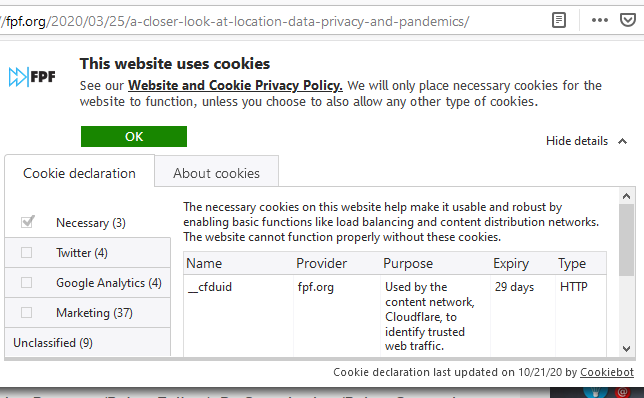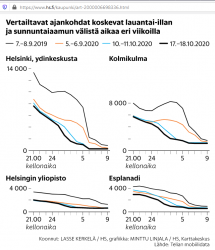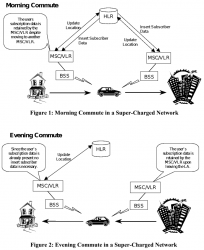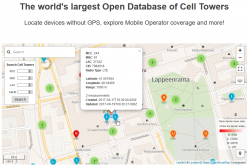Tracking your location via Mobile network
Sunday, October 25. 2020
Privacy, especially your/mine/everybody's, has been an always actual topic ever since The Internet begun its commercial expansion in the beginning of 90s. Being an important topic, it has been thought everybody should have the right for privacy. In EU, the latest regulation is called on the protection of natural persons with regard to the processing of personal data and on the free movement of such data, or General Data Protection Regulation. In California, USA they'd call it California Consumer Privacy Act.
Privacy protection gone wrong
Both above mentioned regulations have good intention. Forcing websites to bombard all of their users with stupid questions are a complete waste of bandwidth! Everybody is tired of seeing popups like this while surfing:

Somehow the good intention turned on itself. Literally nobody wants to make those choices before entering a site. There should be a setting in my browser and all those sites should read the setting and act on it without bothering me.
Mobile phone tracking
Meanwhile, your cell service provider is using your data and you won't be offered a set of checkboxes to tick.
As an example, Telia’s anonymized location data helps Finnish Government fight the coronavirus (April 2020). This corporation has a product called Crowd Insights. Anybody with a reasonable amount of money (actual price of the service is not known) can purchase location data of actual persons moving around a city. There is a brief investigation by Finnish Chancellor of Justice stating that the service is legal and won't divulge any protected data. The decision (unfortunately, only in Finnish) Paikannustietojen hyödyntäminen COVID-19 –epidemian hillinnässä states, the service's data is daily or hourly and while a reasonable accurate location of a mobile device can be obtained, if that location data doesn't identify a person, obviously, it's not protected by any laws.
On the topic of COVID-19, Future of Privacy Forum has published an article A Closer Look at Location Data: Privacy and Pandemics, where they raise points from ethics and privacy perspective of such tracking. A good read, that!
Application of mobile movement tracking
Here is one. A newspaper article titled "Puhelinten sijaintitiedot paljastavat, kuinka ihmismassojen liikkuminen yöllisessä Helsingissä muuttui" (https://www.hs.fi/kaupunki/art-2000006698336.html):

For non-Finnish -speaking readers: this article is about movement of people in center of Helsinki. For a reference point, there is Crowd Insights data from September 2019, time before COVID-19. Movement data from pandemic is from September 5th, October 10th and 17th. To state the obvious: in 2019 between Saturday 9pm and Sunday 9am people moved a lot. What's also visible is how this global pandemic changed this behaviour. In September 2020 there were no strict regulations for night clubs and bars, which is clearly visible in the data.
Anyway, this is the kind of data of you walking around in your hometown streets, your mobile in pocket, can be easily gathered. Doing the same walk without a cell network -connect mobile device wouldn't show in that data set.
What! Are they tracking my movements via my cell phone?
Short: Yes.
Long: Yes. Your cell network provider knows every second to which cell tower all devices in their network are connected to. They also know the exact location of that identified cell tower. This coarse location information can be used by somebody or not.
Everybody knows the Hollywood movie cliché where a phone call is being tracked and somebody throws the frase "Keep them talking longer, we havent' got the trace yet!". In reality they'll know your location if your phone is turned on. It doesn't have to have an ongoing call or message being received. This is how all cell networks are designed and that's how they have always operated. They know your coarse location at all times. How exact a "coarse" location is, depends. Who has access to the location information is protected by multiple laws. The point is: they have the information. At all times.
Example illustration from 3GPP spec TR 23.912 Technical report on Super-Charger:

I'm skipping most the TLA (Three-Letter Acronyms) from the pic, but the main concept is having the car (with a phone in it) moving around the network. A HLR (or Home Location Register) will always keep track, on which BSS (note: I think it's called Radio Network Subsysten, RNS in UMTS and LTE) the mobile device talks to. This BSS (or RNS) will send updates on any jumping between the serving cells.
To simplify this further: Just replace the car with a phone in your pocket and this fully applies to people bar-hopping in center of Helsinki.
Database of cell towers
As the cell tower locations are the key component when pinpointing somebody's location, we need to know which cell towers exist and exact locations of those. Unfortunately telcos think that's a trade secret and won't release such information to general public. At the same time, from our phones we can see the identifier of the cell tower a phone is connected to and some hints to neighbouring cells. I wrote about iPhone field test mode couple years back. What a phone also has is a GPS pinpointing the exact location where a particual cell tower and couple of its friends are located at. When added with the information of, a phone typically connecting to the tower with best signal, it is possible to apply some logic. Further gathering couple of data points more, it is possible to calculate a coarse location of a cell tower your phone connects to.
Being an iPhone user, I'm sorry to say an iPhone is not technically suitable for such information gathering. Fortunately, an Android being much more open (to malware) is. Necessary interfaces exist in Android-system to query for cell tower information with an app like Tower Collector. This kind of software it is possible to create records of cell tower information and send them to OpenCelliD to be further processed and distributed to other interested parties.
OpenCelliD website contains an interactive map:

The above example is from my home town of Lappeenranta, Finland. What it depicts is approximation of a LTE cell tower location having following attributes:
- MCC: 244
- MNC: 91
- LAC: 37322
- CID: 7984918
MCC and MNC indicate the telco. CellID Finder has following information for Finland at https://cellidfinder.com/mcc-mnc#F:
| MCC | MNC | Network | Operator or brand name | Status |
| 244 | 3 | DNA Oy | DNA | Operational |
| 244 | 5 | Elisa Oyj | Elisa | Operational |
| 244 | 9 | Finnet Group | Finnet | Operational |
| 244 | 10 | TDC Oy | TDC | Operational |
| 244 | 12 | DNA Oy | DNA | Operational |
| 244 | 14 | Alands Mobiltelefon AB | AMT | Operational |
| 244 | 15 | Samk student network | Samk | Operational |
| 244 | 21 | Saunalahti | Saunalahti | Operational |
| 244 | 29 | Scnl Truphone | Operational | |
| 244 | 91 | TeliaSonera Finland Oyj | Sonera | Operational |
What a LAC (Location Area Code) and CID indicate cannot be decoded without a database like OpenCelliD. Wikipedia article GSM Cell ID gives some hints about LAC and CID. The page also lists other databases you may want to take a look.
COVID-19 tracking
Apple and Google being the manufactures of major operating systems for mobile devices combined forces and created Exposure Notifications. This technology does NOT utilize cell towers nor GPS it it. It works only on Bluetooth LE.
As mentioned in appropriate Wikipedia article, the protocol is called Decentralized Privacy-Preserving Proximity Tracing (or DP-3T for short).
Finally
The key takeaway from all this is:
Location of your mobile device is always known.
Your location, movements between locations and timestamp you did the moving (or not moving) are actively being used to track everybody of us. That's because the technology in mobile networks requires the information.
If this information is shared to somebody else, that's a completely different story.

